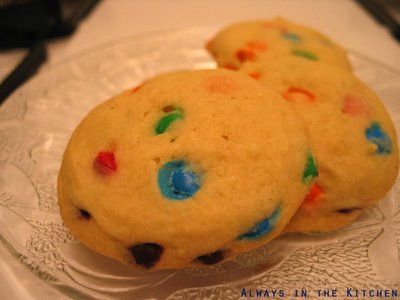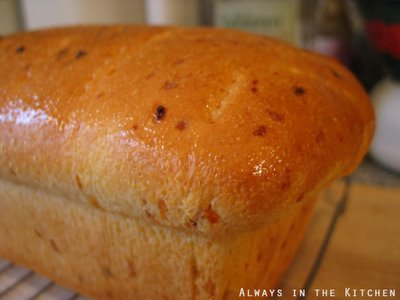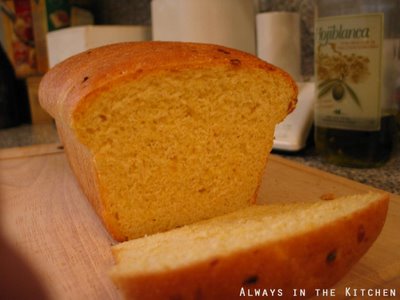Lera of
Myriad Tastes tagged me for the "
You Are What You Eat" meme, and I have to tell you, it's not an easy task to define myself within only ten things, so I'm sure I've overlooked something significant. Due to the restriction of "eating" I have left out beverages, or you can bet that wine would have been on the list, somewhere. Here goes:
10) Bread. I love to bake bread, and while I don't bake every week, or even every month (pizza dough notwithstanding) I enjoy both the process and the result. Bread baking gives a satisfaction that is unparalleled.
From my
essay: "I enjoy making bread by hand for a number of reasons. The scent of yeast, the smooth, warm silky feeling of the dough as it comes together under your hands in the roll and flex of your wrist and fingers. The process of kneading, which drains tension from the maker even as it gives a light workout to the arms. The more a bread is kneaded, the finer the texture of the crumb, so the more anxiety you have to release, the more delicate the bread you produce. That's pure alchemy. I even find simple pleasure in seeing how the bread has risen from the small lump of dough into a magnificent loaf, and the wonderful smell of the bread as it bakes is a panacea for any tired spirit."
9) Homemade pizza. We make pizza at least twice per month. You can hide leftovers on it, or you can made an entire meal with only a few simple ingredients without feeling like you're skimping. It combines the magnificence of homemade bread, with the satisfaction of making a meal. You can load them with things you like, and you can take them into the living room to eat in front of the television, when hockey's on. You can invite some friends over, and have a little feast.
8) Citrus. Lemons and limes get top billing, followed by grapefruit, then oranges, and finally whatever miscellaneous other citrus you might have going. My forays into Jamaican and Mexican food has me more interested in limes these days, but lemons are a great standby. You can make any course of a dinner with citrus, from drinks through desserts and all stops along the way. Citrus juice or rind can pep up almost any side dish, balance the flavours of a stew or soup, or blend with sugar to create marmelades and fabulous sweet baking treats.
7) Chocolate. The darker, the better. Preferably, so dark that light cannot escape its surface. Need more be said?
6) Cheezies. You didn't think this was all going to be healthy food, did you? This is my defining junk snack food. I like the
Hawkins ones best (only available in Canada), but I'll take most varieties of cheesy corn curls in a pinch. This may count as a second vote for cheese (see #2 below), but I don't care.
5) Rice. I have at least three types of rice on hand at all times. My default, go-to rice for side dishes or as a foundation for miscellaneous other dishes, is Jasmine rice. If I say "I'm going to put some rice on," this is what I probably mean. I also have Basmati, which is partially due to my love for Indian food, and Arborio, because I also adore risotto. Sometimes I'll have other varieties on hand - sushi rice, wild rice, etc. I'm very curious about the Chinese
Forbidden Rice - who wouldn't be? I must try some, soon. I eat a lot of pasta, too, and had potatoes nearly every day, growing up, but rice is the dominant dinner-starch in my life these days.
4) Poultry. I'm roasting a duck for Christmas, this year. Roast duck with cherry sauce. Over the nine Christmases we've been together, Palle and I have explored everything from Chicken through pheasant, cornish game hen, goose (twice!), duck, traditional turkey, rouladen of turkey breast, and ham, once, just to be difficult. On non-holiday meals, we eat rather a lot of chicken on a regular basis, and as you can tell from a glance at my
recipe cauldron, it is featured rather prominently.
3) Garlic & Onions. I have a friend who is allergic to the entire lily family, and must eschew fresh onions, garlic, and leeks (fortunately, he can have them in dessicated powder form). Myself, I get a little nervous if I'm down to only one onion, and I buy fresh garlic about once per week - more often on the weeks that I roast chicken. A few years ago, I was out for dinner at a lovely, upscale (and sadly, now closed) Hungarian restaurant called "Bandi's" with author
Steven Brust, among others. He professed his love for onions and garlic to be such that "if it doesn't have onions it had better be dessert, and if it doesn't have garlic, it had better be chocolate!" We gloried in the langos - a fried flatbread that is topped with crushed, uncooked garlic that swims in a little pot of butter while it waits for you to scoop it on top of your langos. Heavenly. Garlic doesn't even register on the Richter scale equivalent of bad breath. If I smell garlic, and I'm not eating garlic, I just feel jealous.
2) Cheese. Cheese is the reason I would never want to go vegan. Seldom does a day pass without a little cheese in it, and that's just the way I like it to be. I'm seldom without at least two different cheeses in the fridge, and often have as many as four or five.
From my
essay: "What other food than cheese has such astonishing variety of texture, character and application? You can slice it for sandwiches or crackers, crumble it over salads or pasta, melt it for fondue, smear it on toast or eat it straight from the knife. It can be an assertive primary flavour, or a subtle matrix that holds a casserole together. It makes a good party even better."
1) Chiles. Much of the food that I eat on a daily basis is fairly spicy. I cook with habaneros without a second thought (as I did last night). Much of what I bring to work as leftovers/lunch elicits oohs and aahs when I take it out of the microwave, but which I know would half-kill most of the people in my office. I didn't set out to be a chilehead; eating some of this stuff would have been nigh impossible for me fifteen years ago. I just love the flavours and the heat comes along as a package deal. My discovery of Mexican food (as opposed to Tex-Mex and Cali-Mex, which I also like, but are very different) and Indian food has only increased the amount of spicy dishes that I order, cook, crave, and eat. I have four different kinds of whole, dried chiles in my storage box right now, and then there are the powdered: Cayenne, Chipotle, Ancho, Japones, Paprika... I'm probably leaving one or two out, actually. And the blends! Cajun mix, Ethiopian berbere, good old-fashioned chili powder, Southwest seasoning, Garam masala, not to mention whole berries: Tellicherry black peppercorns, Szechwan peppercorns... and of course I usually have a fresh chile or two lurking in the fridge. Don't even get me started on
hot sauces!
So, above all, if I am what I eat, I guess I'm spicy. And maybe a little cheesy.
















